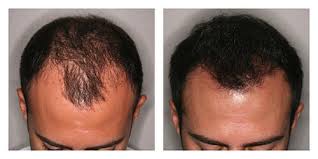PRP is an effective treatment for androgenic (male pattern and female pattern) hair loss Male and female pattern baldness is common and can be embarrassing and/or lowers one’s self-confidence. Hair transplantation is extremely effective, but very costly. Topical medications are somewhat helpful, but have to be applied daily and can leave the scalp feeling greasy. Prescription medications can slow the hair loss and even result in some regrowth.
Now there is a safe and affordable option that can grow hair back using one’s own blood. Platelet-Rich Plasma (PRP) involves taking one’s blood, concentrating the platelets, and injecting it into the vascular layer of the scalp.
What does PRP do?
1. It increases blood flow to the hair follicle
2. It increases the thickness of the hair
3. It increases the number of follicles that are in the growth (anagen) phase
4.It decreases hair loss

How does PRP work?
Platelets contain growth factors that signals tissue to regenerate and/or cells to multiply. PRP is used in many fields of medicine for its regenerative properties. It has been well studied for male and female pattern hair loss with safe and reproducible results.
The PRP procedure for hair loss
1. Approximately 6-8 tubes of blood are drawn up from the patient
2. The platelets are concentrated and put into syringes
3. The concentrated platelets are injected into the affected areas on the scalp using a tiny 30-gauge needle.
Am I a candidate for PRP injections?
If you have Male or Female pattern alopecia, are in good health, are not anemic (i.e. you do NOT have anemia), have no infections on the scalp, then you may be a good candidate for PRP treatment.
How many injections are needed?
Injections are usually performed once a month to establish a response and then 2-3 times a year for maintenance. Many patients will require 2-3 monthly injections followed by a treatment 3 months later for optimal results.
Is the PRP treatment painful?
Most patients tolerate the procedure without the need for any anesthetic. We do offer several options to reduce discomfort: 1. a cold anesthetic spray prior to injection, 2. topical anesthetic, 3. Laughing Gas (at a small additional charge)
Is there any downtime after the PRP treatment?
There is no downtime or recovery after the treatment. You may shower the following morning. Do not use any harsh chemical treatments or hair dyes for at least 2 days.
Will the PRP treatments cure my baldness?
No. There is no cure for androgenic alopecia. Therefore, maintenance treatments will be needed to “maintain” results.
Are all PRP treatments the same?
Absolutely not! There are many different collection systems and methods to concentrate the platelets for PRP, some which are quite costly. Higher cost does not necessarily mean “better” results, but some PRP injections may not be useful at all. Most providers “activate” the platelets prior to injection, others do not. Recent studies have shown that patients treated with platelets that have been “activated” have a better response for the treatment of androgenic alopecia (male- and female-pattern hair loss) than those treated with “non-activated” platelets. Treatment of dermal processes, i.e. “wrinkles”, may not require activation as the body’s collagen activates the platelets, although results have been marginal and the American Academy of Dermatology has not supported this indication for PRP as of 2019.
How much improvement will one see?
Women typically respond better than men. On average, approximately 25% improvement is seen for patients who complete the recommended number of treatments in the first year. Approximately 5% of patients will see no benefit, which cannot be predicted prior to treatment.
